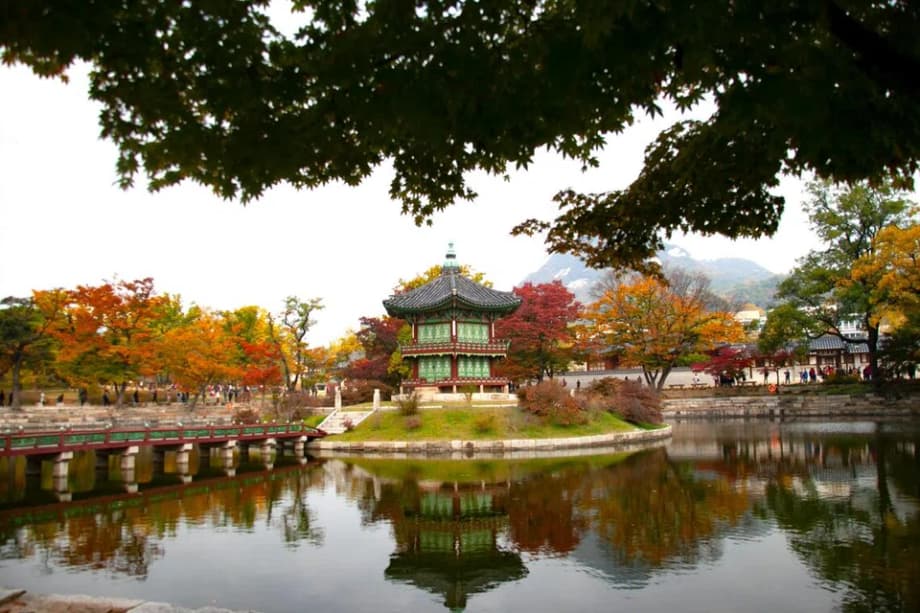A cooler snap, still green trees: why fall is late across South Korea
Across South Korea, scarves and padded jackets are out, yet many city streets remain stubbornly green. The 2025 autumn leaf show, usually ablaze by mid to late October, is lagging. Seoraksan recorded the first snow of the season on Oct 20, with mountaintop readings dipping below zero, while morning temperatures in cities fell several degrees below the usual average. Even so, maples and ginkgoes in Seoul have been slow to turn. The reason sits squarely with heat that lingered far longer than normal. South Korea just came through its hottest summer since modern records began in 1973, with an average of 25.7 degrees Celsius from June to August and a burst of heat waves in July. Warm nights stretched well into late September, when minimum temperatures in many places stayed above 20 degrees until Sept 29. Those conditions delayed the chemistry that creates the bold reds and golds of fall.
- A cooler snap, still green trees: why fall is late across South Korea
- What the data shows across the country
- The science behind delayed color
- Impact on tourism, parks and city life
- First snow arrives while leaves lag behind
- What forecasters expect next
- Practical advice for travelers and residents
- What to Know
Officials tracking forest phenology say the season is running behind schedule. A forecast map released by the Korea Forest Service puts peak color on Surisan, a low mountain south of Seoul, on Oct 31, a couple of days later than last year and nearly two weeks later than a decade ago. The agency defines peak as the moment when about half of a mountain area shows autumn hues. That later timing lines up with what residents see on the ground, especially in lowland parks and neighborhoods where nights stayed mild well into early fall. The shift has real effects for photographers, hikers, and local tourism, since the best days for leaf viewing are drifting closer to November.
What the data shows across the country
Autumn colors in Korea typically progress from the high mountains in the northeast to the south and island regions. Forecasters often measure two milestones. The first foliage stage begins when about one fifth of trees at a mountain summit have turned. Peak arrives when roughly half of the landscape carries fall color. In a standard year, the wave of color moves southward at a pace of about 20 to 25 kilometers per day, but warm early autumn weather can slow the march.
Seoul and central region timelines
In the capital region, many popular hills and peaks reach their best color in late October and early November. Surisan is forecast around Oct 31. Bukhansan, a favorite for weekend hikers and photographers, is expected to hit its peak in the first week of November. Palaces and parks in the city, including Gyeongbokgung, Seoul Forest, Olympic Park, and the lake at Seokchon, usually lag the nearby mountains by several days. Streets known for ginkgo trees, such as the stone wall path at Deoksugung and the campus walkways of Sungkyunkwan University, often come alive in late October and early November as night temperatures finally drop.
South and Jeju later peaks
In the south and on Jeju Island, the color window tends to open later. Official forecasts place Hallasan’s peak near the end of October and Naejangsan in early to mid November. If mild weather persists through late October, experts caution that southern highlights such as Jirisan and Hallasan could slip toward mid November, which would mark one of the latest starts seen in recent years. Local geography adds variation. Valleys that trap warm air or urban heat islands around city centers can both slow the onset of color, while higher ridgelines may turn earlier once nightly lows fall into the single digits.
The science behind delayed color
Leaf color is a seasonal handoff among pigments inside each leaf. In summer, chlorophyll is abundant and gives leaves their green look as it fuels photosynthesis. In fall, shorter days and cooler nights tell trees to prepare for winter. As trees withdraw nutrients back into twigs and branches, chlorophyll breaks down. That process reveals yellow and orange pigments, mainly carotenoids, that were present all along. Reds and purples come from anthocyanins, which are produced in some species when the tree experiences cool, sunny days and crisp nights. Those cool nights are vital for a strong, even transition.
Kim Dong-hak, a research official with the Korea Forest Biodiversity Conservation Division, described the bottleneck created by persistent warmth after summer. He explained why temperatures need to drop for color to arrive on time.
“Temperatures need to fall for the chlorophyll in leaves to break down, but that process has not been happening properly. We saw record high temperatures this summer, and the heat lasted much longer than usual.”
Warm nights slow down the breakdown of chlorophyll, which leaves trees looking green for longer. When warmth lingers too long into autumn, color can arrive in a patchy way, or the full spectrum of reds and golds can be reduced. Sharp, steady drops in temperature, without early frost, usually support more uniform and vivid displays. Prolonged heat, strong wind events, or drought can shorten the window once color has started.
Why warm nights matter more than cool days
Trees respond to both daylight length and temperature, but the daily minimum often carries more weight for the timing of change. When the nighttime low remains above about 5 degrees Celsius, many deciduous species delay senescence. That delay in breaking down chlorophyll also delays the rise of other pigments. The result is a late start and sometimes a compressed peak period. Once night temperatures dip and stay low for several days, the change accelerates. This is why a sudden cold snap can trigger rapid color shifts after a long warm spell, particularly at higher elevations.
Could colors be duller this year?
Research across East Asia and within Korea suggests warming trends do not only delay color, they can soften it. A 30 year analysis of palmate maple and ginkgo across dozens of Korean sites found that leaf senescence has shifted later for both species, with ginkgo changing slightly faster than maple. The strongest predictors were autumn minimum temperatures and day length. Warmer nights pushed the schedule back. Studies in Japan have also linked longer growing seasons and warmer conditions to lower levels of anthocyanin, the red pigment. That change can yield fewer deep reds and more yellow and brown tones, especially in years with lingering warmth and little night time chill. The most vibrant reds tend to emerge when trees cool down gradually, without extremes, under clear skies.
Impact on tourism, parks and city life
Autumn is one of South Korea’s signature travel seasons. Delayed color shifts plans for weekend hikers, photographers, and tour groups. Crowds often swell as soon as leaves peak, and many parks now expect that surge in early November. Cities are adjusting as well. Local festivals timed to the usual late October window have added flexible dates. Transport bookings and accommodation demand have shifted toward the first half of November, especially in Seoul, Busan, and the mountain gateway cities of Gangwon. For workers and families planning short outings, it may pay to target weekdays when trails are quieter.
Popular spots and best windows
Based on official forecasts and recent temperature patterns, these locations are well placed for late October and November viewing:
- Seoul palaces and parks: Gyeongbokgung, Seoul Forest, Olympic Park, and Seokchon Lake often look their best from late October into early November.
- Stone Wall Path at Deoksugung and the ginkgo avenues at Sungkyunkwan University: golden canopies tend to arrive around the same window as central Seoul parks.
- Bukhansan National Park: primary peaks in the first week of November, with color spreading from high ridges downward.
- Nami Island and The Garden of Morning Calm: late October through early November, with strong morning light for photos.
- Naejangsan National Park: early to mid November, famous for temple views framed by fiery maples.
- Jirisan National Park: late October for higher slopes, but mid November remains likely if mild weather lingers.
- Seoraksan National Park: late October around mid elevations, with early color on high ridges already seen. The window can be shorter after first frost or snowfall.
- Hallasan on Jeju Island: late October to early November on main trails, with lower areas trailing a bit later.
Safety and etiquette on the trails
- Start early. Parking fills fast and daylight hours are shorter in late fall.
- Dress in layers. Mornings can be near freezing at altitude, while afternoons in valleys remain mild.
- Carry microtrash out. Many parks have strict pack in, pack out practices.
- Stay on marked paths. Off trail shortcuts harm root systems and fragile understory plants.
- Watch the forecast. Wind and sudden cold fronts can close exposed ridgelines and cable sections.
- Respect quiet zones around temples and heritage sites. Photography is welcome, but drones and loud music are often restricted.
First snow arrives while leaves lag behind
On Oct 20, hikers at Seoraksan reported a thin veil of early season snow, close to 1 centimeter in some high shelter areas. Park officials noted a predawn minimum near minus 1.3 degrees Celsius at elevation. The wintry dusting arrived while much of the mountain’s mid slopes still carried late green, creating rare scenes of mixed seasons. Across the peninsula, a cold air mass from the north made for the coldest morning of the season in many districts, with wind chill readings pushing perceived temperatures even lower. This kind of abrupt shift can spark faster color change in the days that follow, especially in mountains. In cities, the effect usually takes longer to show, since urban surfaces retain heat and keep nights warmer than nearby rural sites.
What forecasters expect next
Meteorologists expect the color wave to keep sliding into November for many lowland areas. Central mountains are on track for late October and early November peaks, while southern and island regions may see their best days in the first half of November if nights keep moderating slowly. The trend, according to forest officials, is a gradual drift toward later starts and later peaks in the leaf season. That drifting schedule can look different place to place, since more frequent climate anomalies add volatility to timing.
Kim Dong-hak, whose team helps compile official maps of the season, said that both the start and peak have been moving later, while the exact dates are getting harder to predict as unusual patterns stack up.
“The general trend is that fall foliage is occurring later in the year, but as more abnormal climate phenomena occur, the variability in when fall foliage appears has increased.”
Practical advice for travelers and residents
- Plan for November. Many prime spots in Seoul and central regions should be close to peak in the first week of the month, with some areas holding color into mid November.
- Check park notices before you go. Trail closures and weather advisories can change quickly after cold snaps.
- Target midweek outings. Weekends bring heavy traffic to Bukhansan, Seoraksan, Naejangsan, and Jirisan.
- Pack a warm layer and windproof shell. Mornings can feel like late November at altitude.
- Catch golden hour light. Early morning and late afternoon produce the richest color contrasts.
- Have a backup plan. If a mountain is crowded or foggy, palace grounds, riverside parks, and botanic gardens often offer shelter and quieter paths.
- Expect variability. A warm spell can slow color again, while a clear cold stretch can accelerate it within days.
What to Know
- South Korea had its hottest summer on record in 2025, and warm nights lasted into late September.
- Peak color is arriving later in many places, with Surisan near Oct 31 and Bukhansan near early November.
- Southern regions and Jeju are likely to hold their best color into early or mid November if mild nights continue.
- Seoraksan recorded the first snow on Oct 20, while many low elevations remained green, highlighting the unusual overlap of seasons.
- Cool, steady nights drive the chemistry that creates fall color. Prolonged warmth delays chlorophyll breakdown.
- Studies in Korea and Japan link warmer conditions to later and sometimes duller colors, especially fewer deep reds.
- For travelers, late October through mid November will be the prime window for most regions in 2025.
- Dress for sharp temperature swings, start early, and check park advisories for weather and trail updates.




